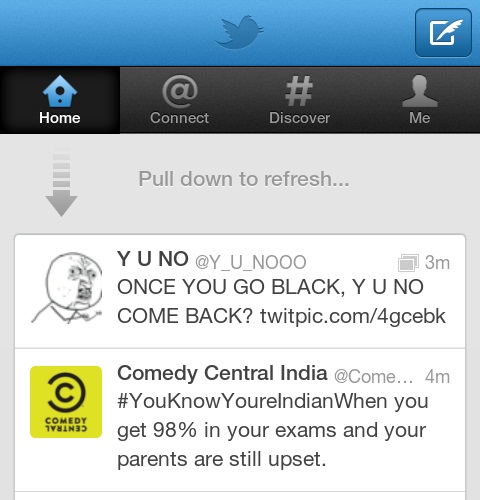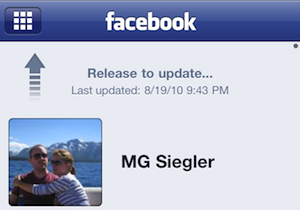
- #TWITTERRIFIC PULL TO REFRESH HOW TO#
- #TWITTERRIFIC PULL TO REFRESH MANUAL#
- #TWITTERRIFIC PULL TO REFRESH CRACK#
Gestures play quite a significant role in Twitterrific. For Favorites, Search, and Lists, you’ll find them buried in the main menu. Adjacent to the navigation bar is a round Compose Tweet button. Personally, I’m not that big of a fan of the top placement, since I have smaller hands and it’s harder for me to reach, but I do admit that it helps to provide a cleaner look. You can also navigate to your mentions and DMs with the peculiarly placed navigational menu at the top of the screen. You can also grab the link URLs on your device clipboard or just view them in the in-app browser. If you find a link that you want to save to Pocket or Instapaper, just tap and hold to bring up the login screen (Pocket uses two-step authorization). Usernames and links are immediately tappable from the timeline view, though for some reason, links in profile bios are not. The way everything was color-coded for instant recognition in Twitterrific was one of my favorite things from previous versions, so I’m glad that it stayed in version 5. Mentions will be in orange, DMs in blue, and your own tweets are green. Of course, you can toggle this off in Settings (two taps). With the Unified timeline, any time you are mentioned in a tweet, even from someone you do not follow, it will show up in your timeline. Twitterrific features the “Unified Timeline,” or “Siracusa mode,” as some would call it. The main menu can be accessed by tapping on your avatar in the top left. If you are going to use Twitterrific, it’s probably best if you use it with your main account. Multiple accounts are supported, though I have found it can be a bit of a hassle to switch between them, requiring three taps to do so for each. Twitterrific will use the native Twitter login info that you have stored on iOS, but you can also add an account manually. It’s quite a beautiful little animation, and one of my favorite things about Twitterrific 5.
#TWITTERRIFIC PULL TO REFRESH CRACK#
As you pull the screen down, an egg will crack and hatch an Ollie bird, who then proceeds to flap its wings as the timeline refreshes.

#TWITTERRIFIC PULL TO REFRESH MANUAL#
Oh, and this time? There’s finally pull-to-refresh, or well, “Ollie-to-refresh,” as some may call it, rather than a manual refresh button. It has been rebuilt from scratch, and it has never looked better. If you had previously bought Twitterrific, you will see that Twitterrific 5 is not an update, but rather, a completely new app. And now, at the end of 2012, we have the fifth iteration of the first iOS Twitter client. And since 2008, Twitterrific has gone through many design and interface changes with each major release. Many of us, including myself, had this as our first Twitter app on the iPhone, that is, probably until Tweetie or Tweetbot came along. Twitterrific made a splash when the App Store first opened back in 2008 since it was the first Twitter app available for iPhone users. Rather than provide everything but the kitchen sink, such as my long-time favorite, Tweetbot, Twitterrific makes it a pleasure to actually indulge in your timeline. So let’s build a SampleListView widget that resembles this.ġ import 'package:flutter/material.dart' Ģ import 'package:flutter_app/sample_list_view.Twitterrific 5 ($2.99) by The Iconfactory is the minimalistic approach to Twitter.

Typically, there is a list of elements that is being refreshed when the indicator is shown. Prerequisitesīefore we jump right into the implementation, let’s build a sample widget we can test our implementation on. This is the place where you typically trigger fetching new data. onRefresh is a callback function that is called when the refresh indicator has been dragged far enough to the bottom. child represents the widget that should be refreshed on pull down. The widget’s constructor has two arguments. When the user releases its finger / cursor and the indicator has been dragged far enough to the bottom, it will call the provided callback ( onRefresh). Whenever the child‘s Scrollable ist overscrolled, the circular progress indicator is shown on top. RefreshIndicator is a usual widget that is supposed to be wrapped around the widget which you want to give the ability to be reloaded on pull down.
#TWITTERRIFIC PULL TO REFRESH HOW TO#
It’s called RefreshIndicator there.īut how do we use this handy UI element? And how does it play together with alternative state management solutions such as BLoC pattern? How to use RefreshIndicator No surprise this feature is also represented in the Flutter standard library. The pull-to-refresh gesture is a popular UI mechanic that is used not only in Google’s Material Design, but also in Apple’s Human Interface Guidelines.


 0 kommentar(er)
0 kommentar(er)
